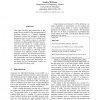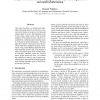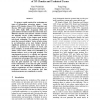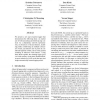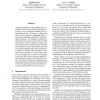104
Voted
NAACL
2003
15 years 2 months ago
2003
This paper describes the construction of language choice models for the microplanning of discourse relations in a Natural Language Generation system that attempts to generate appr...
104
Voted
NAACL
2003
15 years 2 months ago
2003
e by placing terms in an abstract ‘information space’ based on their occurrences in text corpora, and then allowing a user to visualize local regions of this information space....
112
Voted
NAACL
2003
15 years 2 months ago
2003
This paper describes an unsupervised algorithm for placing unknown words into a taxonomy and evaluates its accuracy on a large and varied sample of words. The algorithm works by �...
120
Voted
NAACL
2003
15 years 2 months ago
2003
This demonstration involves two-way automatic speechto-speech translation on a consumer off-the-shelf PDA. This work was done as part of the DARPA-funded Babylon project, investig...
106
Voted
NAACL
2003
15 years 2 months ago
2003
We propose a gold standard for evaluating two types of information extraction output -- noun phrase (NP) chunks (Abney 1991; Ramshaw and Marcus 1995) and technical terms (Justeson...
112
Voted
NAACL
2003
15 years 2 months ago
2003
Evaluating competing technologies on a common problem set is a powerful way to improve the state of the art and hasten technology transfer. Yet poorly designed evaluations can was...
101
Voted
NAACL
2003
15 years 2 months ago
2003
We present a new part-of-speech tagger that demonstrates the following ideas: (i) explicit use of both preceding and following tag contexts via a dependency network representation...
NAACL
2003
15 years 2 months ago
2003
83
Voted
NAACL
2003
15 years 2 months ago
2003
Homograph ambiguity is an original issue in Text-to-Speech (TTS). To disambiguate homograph, several efficient approaches have been proposed such as part-of-speech (POS) n-gram, B...
114
Voted
NAACL
2003
15 years 2 months ago
2003
Statistical measures of word similarity have application in many areas of natural language processing, such as language modeling and information retrieval. We report a comparative...
